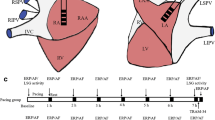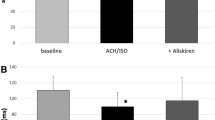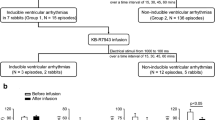Abstract
We investigated the effects of a 7-day verapamil pretreatment (VPT, 7.5 mg/kg bodyweight subcutaneously every 12 h) on ionic currents and molecular mechanisms underlying tachycardia-induced early electrical remodeling after 24-h rapid atrial pacing (RAP, 600 bpm) in rabbit atrium. Animals were divided into four groups (n = 6 each group): control (not paced, no verapamil), paced only, verapamil only and verapamil and paced, respectively. VPT doubled ICa,L [7.0 ± 0.7 pA/pF (control) vs 14.2 ± 0.6 pA/pF (verapamil only)]. RAP reduced ICa,L by 48% to 3.6 ± 0.7 pA/pF (paced only). RAP did not affect ICa,L in verapamil-treated animals and averaged 15.3 ± 0.2 pA/pF (paced and verapamil). RAP resulted in a significant decrease of the expression of the α1c subunit (−24.7%) and the β2A subunit (−13.3%), respectively. VPT led to a similar alteration of subunit expression as RAP [“control” vs “verapamil only”, decrease of α1c subunit (−25.4%), but no significant change in β2A subunit expression]. However, after VPT, further diminishment of α1c and β2A subunit expression after rapid atrial pacing was absent. (“verapamil” vs “verapamil and paced”, n = 6 both groups). RAP decreased Ito [−45%, 51.5 ± 3.9 pA/pF (control) vs 26.8 ± 1.5 pA/pF (paced only)] and was not influenceable by VPT. IK1 was neither affected by RAP nor verapamil pretreatment. Downregulation of α1c and β2A subunit expression and the resulting decay of ICa,L current densities were prevented by verapamil. However, these effects are abolished by multiple other adverse effects of verapamil on atrial electrophysiology.



Similar content being viewed by others
References
Allessie MA (1998) Atrial electrophysiologic remodeling: another vicious circle? J Cardiovasc Electrophysiol 9:1378–1393
Allessie MA, Boyden PA, Camm AJ, Kleber AG, Lab MJ, Legato MJ, Rosen MR, Schwartz PJ, Spooner PM, Van W, Waldo AL (2001) Pathophysiology and prevention of atrial fibrillation. Circulation 103:769–777
Bosch RF, Nattel S (2002) Cellular electrophysiology of atrial fibrillation. Cardiovasc Res 54:259–269
Bosch RF, Scherer CR, Rub N, Wohrl S, Steinmeyer K, Haase H, Busch AE, Seipel L, Kuhlkamp V (2003) Molecular mechanisms of early electrical remodeling: transcriptional downregulation of ion channel subunits reduces I(Ca,L) and I(to) in rapid atrial pacing in rabbits. J Am Coll Cardiol 41:858–869
Bosch RF, Wang Z, Li GR, Nattel S (1999a) Electrophysiological mechanisms by which hypothyroidism delays repolarization in guinea pig hearts. Am J Physiol 277:H211–H220
Bosch RF, Zeng X, Grammer JB, Popovic K, Mewis C, Kuhlkamp V (1999b) Ionic mechanisms of electrical remodeling in human atrial fibrillation. Cardiovasc Res 44:121–131
Brice NL, Berrow NS, Campbell V, Page KM, Brickley K, Tedder I, Dolphin AC (1997) Importance of the different beta subunits in the membrane expression of the alpha1A and alpha2 calcium channel subunits: studies using a depolarization-sensitive alpha1A antibody. Eur J Neurosci 9:749–759
Brundel BJ, Van Gelder IC, Henning RH, Tuinenburg AE, Deelman LE, Tieleman RG, Grandjean JG, Van Gilst WH, Crijns HJ (1999) Gene expression of proteins influencing the calcium homeostasis in patients with persistent and paroxysmal atrial fibrillation. Cardiovasc Res 42:443–454
Brundel BJ, Henning RH, Kampinga HH, Van Gelder IC, Crijns HJ (2002) Molecular mechanisms of remodeling in human atrial fibrillation. Cardiovasc Res 54:315–324
Chien AJ, Zhao X, Shirokov RE, Puri TS, Chang CF, Sun D, Rios E, Hosey MM (1995) Roles of a membrane-localized beta subunit in the formation and targeting of functional L-Type Ca2+ channels. J Biol Chem 270:30036–30044
Chouabe C, Drici MD, Romey G, Barhanin J (2000) Effects of calcium channel blockers on cloned cardiac K+ channels IKr and IKs. Therapie 55:195–202
Christ T, Boknik P, Wohrl S, Wettwer E, Graf EM, Bosch RF, Knaut M, Schmitz W, Ravens U, Dobrev D (2004) L-Type Ca2+ current downregulation in chronic human atrial fibrillation is associated with increased activity of protein phosphatases. Circulation 110:2651–2657
Colecraft HM, Alseikhan B, Takahashi SX, Chaudhuri D, Mittman S, Yegnasubramanian V, Alvania RS, Johns DC, Marban E, Yue DT (2002) Novel functional properties of Ca(2+) channel beta subunits revealed by their expression in adult rat heart cells. J Physiol 541:435–452
Daoud EG, Knight BP, Weiss R, Bahu M, Paladino W, Goyal R, Man KC, Strickberger SA, Morady F (1997) Effect of verapamil and procainamide on atrial fibrillation-induced electrical remodeling in humans. Circulation 96:1542–1550
Davison R, Hartz R, Kaplan K, Parker M, Feiereisel P, Michaelis L (1985) Prophylaxis of supraventricular tachyarrhythmia after coronary bypass surgery with oral verapamil: a randomized, double-blind trial. Ann Thorac Surg 39:336–339
Deschenes I, Tomaselli GF (2002) Modulation of Kv4.3 current by accessory subunits. FEBS Lett 528:183–188
Dobrev D (2004) [Molecular basis of remodelling in atrial fibrillation]. Dtsch Med Wochenschr 129:827–830
Duytschaever MF, Garratt CJ, Allessie MA (2000) Profibrillatory effects of verapamil but not of digoxin in the goat model of atrial fibrillation. J Cardiovasc Electrophysiol 11:1375–1385
Fareh S, Villemaire C, Nattel S (1998) Importance of refractoriness heterogeneity in the enhanced vulnerability to atrial fibrillation induction caused by tachycardia-induced atrial electrical remodeling. Circulation 98:2202–2209
Fareh S, Benardeau A, Thibault B, Nattel S (1999) The T-Type Ca(2+) Channel blocker mibefradil prevents the development of a substrate for atrial fibrillation by tachycardia-induced atrial remodeling in dogs. Circulation 100:2191–2197
Gao T, Chien AJ, Hosey MM (1999) Complexes of the alpha1C and beta subunits generate the necessary signal for membrane targeting of class C L-type calcium channels. J Biol Chem 274:2137–2144
Gao T, Cuadra AE, Ma H, Bunemann M, Gerhardstein BL, Cheng T, Eick RT, Hosey MM (2001) C-terminal fragments of the alpha 1C (CaV1.2) subunit associate with and regulate L-type calcium channels containing C-terminal-truncated alpha 1C subunits. J Biol Chem 276:21089–21097
Gao Z, Lau CP, Chiu SW, Li GR (2004) Inhibition of ultra-rapid delayed rectifier K+ current by verapamil in human atrial myocytes. J Mol Cell Cardiol 36:257–263
Gaspo R, Bosch RF, Talajic M, Nattel S (1997) Functional mechanisms underlying tachycardia-induced sustained atrial fibrillation in a chronic dog model. Circulation 96:4027–4035
Grammer JB, Bosch RF, Kuhlkamp V, Seipel L (2000) Molecular remodeling of Kv4.3 potassium channels in human atrial fibrillation. J Cardiovasc Electrophysiol 11:626–633
Grammer JB, Zeng X, Bosch RF, Kuhlkamp V (2001) Atrial L-type Ca2+-channel, beta-adrenorecptor, and 5-hydroxytryptamine type 4 receptor MRNAs in human atrial fibrillation. Basic Res Cardiol 96:82–90
Gurnett CA, De Waard M, Campbell KP (1996) Dual function of the voltage-dependent Ca2+ channel alpha 2 delta subunit in current stimulation and subunit interaction. Neuron 16:431–440
Haase H, Pfitzmaier B, McEnery MW, Morano I (2000) Expression of Ca(2+) channel subunits during cardiac ontogeny in mice and rats: identification of fetal alpha(1C) and beta subunit isoforms. J Cell Biochem 76:695–703
Herzig S, Neumann J (2000) Effects of serine/threonine protein phosphatases on ion channels in excitable membranes. Physiol Rev 80:173–210
Hohaus A, Poteser M, Romanin C, Klugbauer N, Hofmann F, Morano I, Haase H, Groschner K (2000) Modulation of the smooth-muscle L-type Ca2+ channel alpha1 subunit (alpha1C-b) by the beta2a subunit: a peptide which inhibits binding of beta to the I-II linker of alpha1 induces functional uncoupling. Biochem J 348(Pt 3):657–665
Kamp TJ, Hell JW (2000) Regulation of cardiac L-type calcium channels by protein kinase A and protein kinase C. Circ Res 87:1095–1102
Khairy P, Nattel S (2002) New insights into the mechanisms and management of atrial fibrillation. CMAJ 167:1012–1020
Kinebuchi O, Mitamura H, Shiroshita-Takeshita A, Kurita Y, Ieda M, Ohashi N, Fukuda Y, Sato T, Miyoshi S, Hara M, Takatsuki S, Nagumo M, Ogawa S (2004) Oral verapamil attenuates the progression of pacing-induced electrical and mechanical remodeling of the atrium. Circ J 68:494–500
Koike Y, Shimamura K, Shudo I, Saito H (1979) Pharmacokinetics of verapamil in man. Res Commun Chem Pathol Pharmacol 24:37–47
Kurita Y, Mitamura H, Shiroshita-Takeshita A, Yamane A, Ieda M, Kinebuchi O, Sato T, Miyoshi S, Hara M, Takatsuki S, Ogawa S (2002) Daily oral verapamil before but not after rapid atrial excitation prevents electrical remodeling. Cardiovasc Res 54:447–455
Lai LP, Su MJ, Lin JL, Lin FY, Tsai CH, Chen YS, Huang SK, Tseng YZ, Lien WP (1999) Down-regulation of L-type calcium channel and sarcoplasmic reticular Ca(2+)-ATPase MRNA in human atrial fibrillation without significant change in the MRNA of ryanodine receptor, calsequestrin and phospholamban: an insight into the mechanism of atrial electrical remodeling. J Am Coll Cardiol 33:1231–1237
Lee SH, Yu WC, Cheng JJ, Hung CR, Ding YA, Chang MS, Chen SA (2000) Effect of verapamil on long-term tachycardia-induced atrial electrical remodeling. Circulation 101:200–206
Lee KT, Chu CS, Lin TH, Yen HW, Voon WC, Sheu SH, Lai WT (2007) Effects of verapamil on superior vena cava electrical remodeling induced by short-term pacing from right atrium and superior vena cava in human. Int J Cardiol 120:380–386
Moriguchi M, Niwano S, Yoshizawa N, Kojima J, Inuo K, Izumi T (2003) Verapamil suppresses the inhomogeneity of electrical remodeling in a canine long-term rapid atrial stimulation model. Pacing Clin Electrophysiol 26:2072–2082
Radicke S, Cotella D, Graf EM, Banse U, Jost N, Varro A, Tseng GN, Ravens U, Wettwer E (2006) Functional modulation of the transient outward current Ito by KCNE beta-subunits and regional distribution in human non-failing and failing hearts. Cardiovasc Res 71:695–703
Rampe D, Wible B, Fedida D, Dage RC, Brown AM (1993) Verapamil blocks a rapidly activating delayed rectifier K+ channel cloned from human heart. Mol Pharmacol 44:642–648
Rolf S, Haverkamp W, Borggrefe M, Musshoff U, Eckardt L, Mergenthaler J, Snyders DJ, Pongs O, Speckmann EJ, Breithardt G, Madeja M (2000) Effects of antiarrhythmic drugs on cloned cardiac voltage-gated potassium channels expressed in Xenopus oocytes. Naunyn Schmiedebergs Arch Pharmacol 362:22–31
Schotten U, Haase H, Frechen D, Greiser M, Stellbrink C, Vazquez-Jimenez JF, Morano I, Allessie MA, Hanrath P (2003) The L-type Ca2+-channel subunits alpha1C and beta2 are not downregulated in atrial myocardium of patients with chronic atrial fibrillation. J Mol Cell Cardiol 35:437–443
Schroder E, Magyar J, Burgess D, Andres D, Satin J (2007) Chronic verapamil treatment remodels ICa,L in mouse ventricle. Am J Physiol Heart Circ Physiol 292:H1906–H1916
Schutz E, Ha HR, Buhler FR, Follath F (1982) Serum concentration and antihypertensive effect of slow-release verapamil. J Cardiovasc Pharmacol 4(Suppl 3):S346–S349
Seitelberger R, Hannes W, Gleichauf M, Keilich M, Christoph M, Fasol R (1994) Effects of diltiazem on perioperative ischemia, arrhythmias, and myocardial function in patients undergoing elective coronary bypass grafting. J Thorac Cardiovasc Surg 107:811–821
Shenasa M, Kus T, Fromer M, LeBlanc RA, Dubuc M, Nadeau R (1988) Effect of intravenous and oral calcium antagonists (diltiazem and verapamil) on sustenance of atrial fibrillation. Am J Cardiol 62:403–407
Smith EE, Shore DF, Monro JL, Ross JK (1985) Oral verapamil fails to prevent supraventricular tachycardia following coronary artery surgery. Int J Cardiol 9:37–44
Takahashi M, Seagar MJ, Jones JF, Reber BF, Catterall WA (1987) Subunit structure of dihydropyridine-sensitive calcium channels from skeletal muscle. Proc Natl Acad Sci USA 84:5478–5482
Tieleman RG, Van Gelder IC, Crijns HJ, De Kam PJ, Van Den Berg MP, Haaksma J, Van Der Woude HJ, Allessie MA (1998) Early recurrences of atrial fibrillation after electrical cardioversion: a result of fibrillation-induced electrical remodeling of the atria? J Am Coll Cardiol 31:167–173
Van Gelder IC, Brundel BJ, Henning RH, Tuinenburg AE, Tieleman RG, Deelman L, Grandjean JG, De Kam PJ, Van Gilst WH, Crijns HJ (1999) Alterations in gene expression of proteins involved in the calcium handling in patients with atrial fibrillation. J Cardiovasc Electrophysiol 10:552–560
Van Wagoner DR, Pond AL, McCarthy PM, Trimmer JS, Nerbonne JM (1997) Outward K+ current densities and Kv1.5 expression are reduced in chronic human atrial fibrillation. Circ Res 80:772–781
Van Wagoner DR, Pond AL, Lamorgese M, Rossie SS, McCarthy PM, Nerbonne JM (1999) Atrial L-type Ca2+ currents and human atrial fibrillation. Circ Res 85:428–436
Wang Z, Feng J, Shi H, Pond A, Nerbonne JM, Nattel S (1999) Potential molecular basis of different physiological properties of the transient outward K+ current in rabbit and human atrial myocytes. Circ Res 84:551–561
Wijffels MC, Kirchhof CJ, Dorland R, Allessie MA (1995) Atrial fibrillation begets atrial fibrillation. A study in awake chronically instrumented goats. Circulation 92:1954–1968
Workman AJ, Kane KA, Rankin AC (2001) The contribution of ionic currents to changes in refractoriness of human atrial myocytes associated with chronic atrial fibrillation. Cardiovasc Res 52:226–235
Xiao RP, Cheng H, Lederer WJ, Suzuki T, Lakatta EG (1994) Dual regulation of Ca2+/calmodulin-dependent kinase II activity by membrane voltage and by calcium influx. Proc Natl Acad Sci USA 91:9659–9663
Yamagishi T, Ishii K, Taira N (1995) Antiarrhythmic and bradycardic drugs inhibit currents of Cloned K+ channels, KV1.2 and KV1.4. Eur J Pharmacol 281:151–159
Yamaguchi H, Hara M, Strobeck M, Fukasawa K, Schwartz A, Varadi G (1998) Multiple modulation pathways of calcium channel activity by a beta subunit. Direct evidence of beta subunit participation in membrane trafficking of the alpha1C subunit. J Biol Chem 273:19348–19356
Yue L, Feng J, Gaspo R, Li GR, Wang Z, Nattel S (1997) Ionic remodeling underlying action potential changes in a canine model of atrial fibrillation. Circ Res 81:512–525
Yue L, Feng JL, Wang Z, Nattel S (2000) Effects of ambasilide, quinidine, flecainide and verapamil on ultra-rapid delayed rectifier potassium currents in canine atrial myocytes. Cardiovasc Res 46:151–161
Zhang S, Sawanobori T, Hirano Y, Hiraoka M (1997) Multiple modulations of action potential duration by different calcium channel blocking agents in guinea pig ventricular myocytes. J Cardiovasc Pharmacol 30:489–496
Zhang S, Zhou Z, Gong Q, Makielski JC, January CT (1999) Mechanism of block and identification of the verapamil binding domain to HERG potassium channels. Circ Res 84:989–998
Acknowledgments
The work was supported by the Bundesministerium für Bildung und Forschung Germany (BMBF)/University of Tübingen (IZKF; No. 01KS9602) and the “Kompetenznetz Vorhofflimmern” (No. 01GI0204). The authors thank Jeannette Gogel for expert technical assistance and Hannelore Haase (Max-Dellbrück Zentrum Berlin, Germany) for supply of antibodies.
Author information
Authors and Affiliations
Corresponding author
Rights and permissions
About this article
Cite this article
Laszlo, R., Winkler, C., Wöhrl, S. et al. Effect of verapamil on tachycardia-induced early cellular electrical remodeling in rabbit atrium. Naunyn-Schmied Arch Pharmacol 376, 231–240 (2007). https://doi.org/10.1007/s00210-007-0188-0
Received:
Accepted:
Published:
Issue Date:
DOI: https://doi.org/10.1007/s00210-007-0188-0




